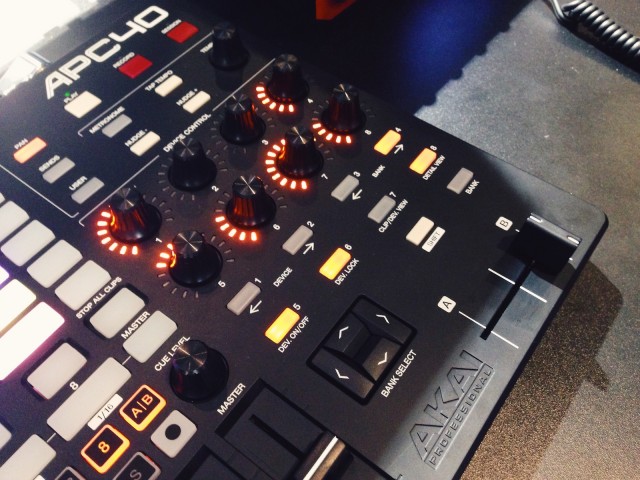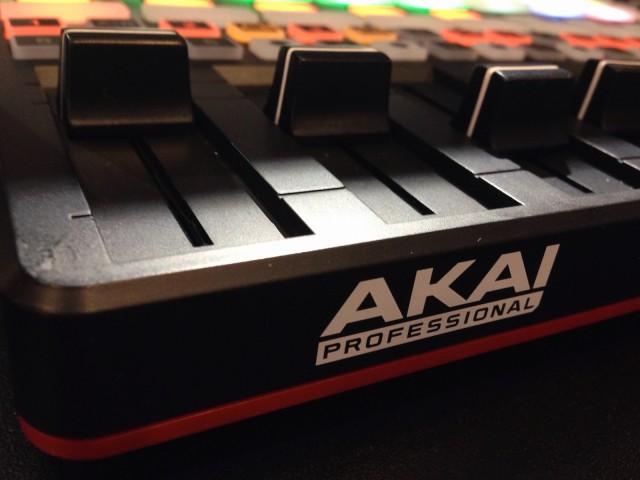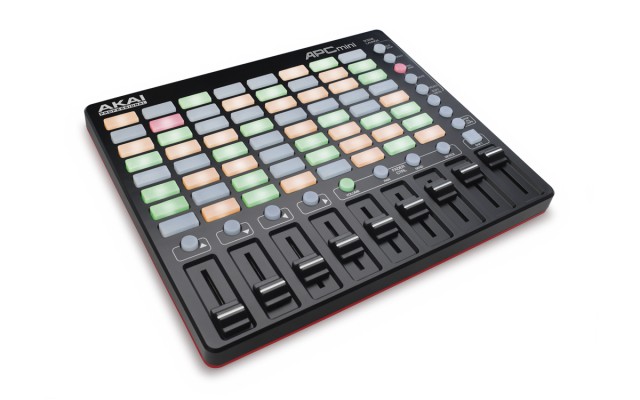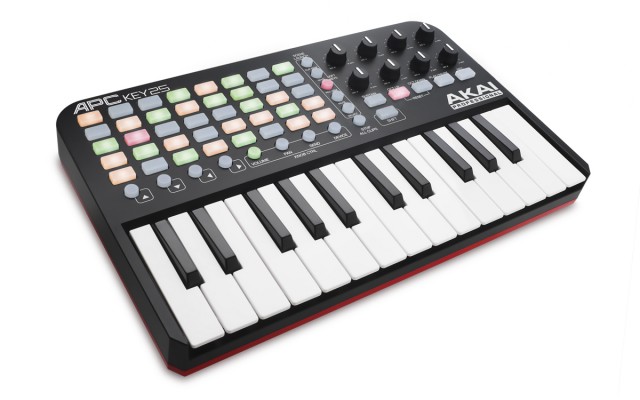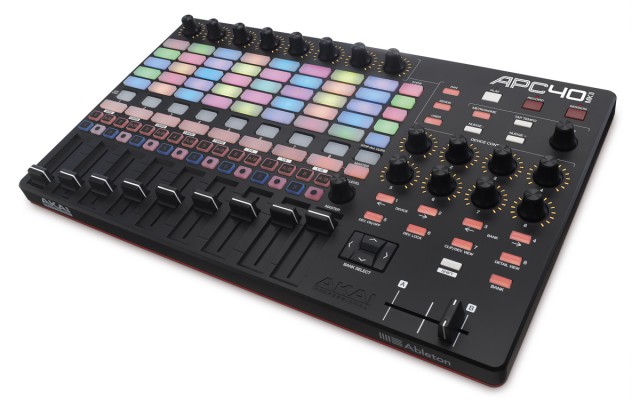
Keyboard and controls and triggers all in one tiny bus-powered unit for just over $100 street. The APC this year also goes tiny.
For any tool that has “live” in the name, physical control will always be important. And so even with a broad market for controllers targeting Ableton’s flagship software, now including the slick Push hardware from Ableton themselves, AKAI’s re-vamped APC line earned intense interest when it debuted at Musikmesse this month.
Let’s make sense of what the new APCs can do and how you might choose between models. I got some hands-on time at Messe, and now even in advance of a review of finished, shipping hardware, it’s worth teasing out the breakdown of the 2014 APC line.
The original Akai APC, short for Ableton Performance Controller (despite obvious, intentional similarity to “MPC”), came out in 2009. Then, there was just one model, the APC40, later seeing a companion, cut-down APC20.
Now, there are three distinct models:
APC MINI. US$99 street. This is a serious challenger to the currently popular entry-level favorite, the Novation Launchpad. In addition to a Launchpad-style 8×8 grid with three-color feedback, you get the faders (8 channel + 1 master) the Launchpad is missing.
APC Key 25. $129 street. Basically, imagine a tiny Ableton control surface squeezed into AKAI’s mini-keyboard: clip matrix plus 8 controller knobs.
APC40 mkII. $399. You get the triggers and faders as on the MINI, but also a crossfader, dedicated mix controls, and, crucially, Device controls.
There are a number of features these units have in common.
They’re USB bus-powered. You don’t need a power supply as on the original APC – a big leap forward in convenience.
They don’t require drivers. Hackers, that means you could make these controllers for other software, like Renoise, Bitwig Studio, Reaper, or your custom SuperCollider rig.
There’s a bunch of great software included. AIR Music Tech is one of the most exceptional plug-in developers around. Unfortunately, while Avid Pro Tools users know their wares fairly well, they’re less known among other users. This could change that: the lovely Hybrid 3 instrument is included in the box even on the APC MINI and APC Key 25 – which for me means it’s going to be hard not justifying buying at least one of those. The crazy-cool SONiVOX Twist morphing synth is included on the APC Key 25 and APC40 mk II. And, okay, sample packs and Live Lite – but getting one or two great synths is what’s likely to sweeten the pot for readers here.
You have a ridiculous number of shortcuts. This is a bit unclear just looking at the units and press materials, but there are triggers that let you access mix values, panning, and sends. In fact, repeatedly triggering the send key lets you control sends for any track, and toggle through as many sends as you’ve gotten. (On the mkII, there are dedicated send triggers up to 8, which is about as many as I’ve seen anyone use who isn’t named Richie Hawtin.) Even on the tiniest APCs, you can control nearly anything; on the mkII, you can do so with more dedicated controls and a mixer-style layout.
You have to get the hang of the SHIFT key and triggers, but once you do, you’ll find dedicated controls for:
- Clip stop
- Track controls: select, mute, solo, record arm
- Knob controls: Volume, Pan, Send (any send, as I said), and Device
- Transport controls (minus the APC MINI)
And you get those on the entire line. So, you’d absolute need them on bigger controllers, yes, but seeing them in a little tiny keyboard is really nice. Mobile musicians I think will really like this.

Specialized trigger shortcuts can map a variety of parameters to the onboard controls, across the whole APC line. This is the Keys 25 close up.
The APC40 mkII could turn out to be the most logical, dedicated mix controller for Ableton yet. There are more generic controllers on the market – the upcoming Dubspot – Livid collab is one to watch. And the APC40 is definitely set up with Ableton in mind. But it is as such terrifically logical when it comes to accessing mix controls – in stark contrast to Ableton’s Push.
In fact, Push and the APC40 mkII would make a nice pair. Push focuses on creative tasks and starting tracks, step sequencing, instrumental playback, and parameter control. The APC40 mkII focuses on traditional mixing tasks: you get conventional channel strips, a crossfader, shortcuts for assigning tracks to the different crossfader buses, mix parameter controls, and a separate Device control section.
The Device controllers were one of the best features of the original APC. What’s nice on this year’s model is that the layout finally looks like a conventional mixer, with parameters right by the faders.

The APC40 mkII now really looks like the mixer strips in Ableton’s Session View. Knobs are at the top, and can be mapped to pan or sends. And note the dedicated A and B buttons for assigning tracks quickly to the crossfader. That could make the APC40 mkII a preferred controller for live/DJ use.
These aren’t instrumental grid controllers. Readers were asking if the pads meant velocity control. They don’t. Oh, and here’s another confusing thing about the lineup from InMusic (Akai/Alesis/Numark/M-Audio etc.) in 2014. Previously, “AKAI” products came with MPC-style, velocity-sensing pads, which made sense – the MPC was always an AKAI product. Now, Alesis keyboards have the 4×4 MPC pads with velocity, and AKAI is putting Ableton controllers on a keyboard without velocity.
Note: that means the one you can use as an instrument is, of course, the AKAI Keys 25, with its two octaves of velocity-sensitive keys.
The APC40 mkII is no Push. In feel and looks, the APC40 mkII feels has none of the luxurious fit and finish of Push, either. Now, what that means for actual, real-world ruggedness is impossible to say, but the user experience is certainly of a less-expensive product.
First impression?
It’s pretty clear the entry-level models are a no-brainer if you need something ultra-portable. The APC Key 25 is surprisingly capable, with 8 controller knobs and a trigger matrix. The APC MINI does what many Novation Launchpad owners wished that control surface did: it adds faders. (Novation’s Launch Control add-on, actually, could be a nice combo with the APC MINI: the APC MINI’s faders work for mixing while the Launch Control could have dedicated Device controllers. It seems, somehow, Laptop Battle worthy.)
Why would you get a Launchpad in place of the APC MINI, then? The Launchpad has a more flexible grid, since it can be used as an instrumental source (minus velocity), or a step sequencer. If you only want to trigger clips with that grid, the APC has an edge, but for these other functions it appears the Launchpad is preferable. (We’ll see how hackable the APC is there, though the square-form-factor grid on the Launchpad is also better suited to these tasks.)
The Launchpad’s button-only controls are also unusually rugged, as you don’t have faders to break off.
The APC40 mkII is in a trickier spot. At $400, you’re approaching the price of the Ableton Push, plus some very beautifully-made offerings from the likes of Livid Instruments and Faderfox. And my concern is that the APC40 mkII feels a little too much like its cheaper counterparts.
In contrast to the firm triggers on the original APC, the model on the Messe show floor has squishy-feeling pads. Since those pads aren’t velocity-sensitive, I would have happily had something firmer. The faders also feel pretty basic in comparison to some rival pieces at the same price. And it’s worth comparing the APC40 mkII to Push, because Push even gives AKAI an engineering credit on the box. I wish some of that aesthetic and feel had rubbed off on AKAI’s line.
That said, the APC40 mkII has a serious edge in terms of layout and controls for a lot of applications. The A/B assignment and crossfader alone will win over some users. And all around, it’s a logical counterpart to Push’s focus on instrumental playing. If what you want from a Live controller is clip triggering, mixing, faders, and parameter control, any one of the APCs here can quickly become the hardware to beat. And on the mkII APC40, you do get a logical evolution of the functionality and control of the breakout-hit original.
So, I look forward to testing the final units. We’ve got some time: AKAI says they expect to be done around summertime. And that will be the time to really test the feel and durability of the gear.
All of this is to say nothing of the M-Audio Trigger Finger Pro, also from InMusic. I was pleasantly surprised by the step sequencing functionality of that, particularly in standalone mode – more on that soon.
2014 should be a good year for controllers. I hope we see more of the usual DIY and creative applications, too, of course, not just what’s at the trade shows. Stay tuned, as always.
http://www.akaipro.com/tradeshows/messe2014

